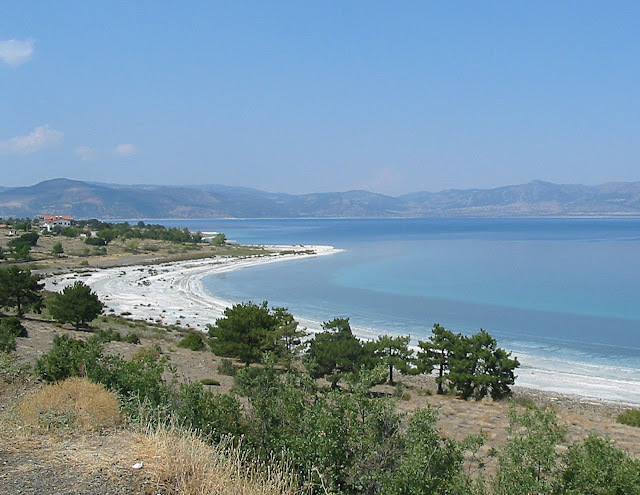Me es grato publicar hoy, un artículo de Carla Lagendijk, de nacionalidad holandesa, con quien comparto la afición del coleccionismo de arenas y sobre todo, su amistad.
Agradezco a la autora su colaboración en mi blog.
During one of
my vacations in Turkey, I got the
opportunity to visit the beautiful lake Salda [in turkish: Salda Gölü] , one of
the deepest lakes in Turkey. It is lying in the southwest Anatolia region, in
the province of Burdur , 4 km. WNW of Yesilova.
Driving along
the E 87 into the direction of the ancient site of Hierapolis and the
impressive travertine terraces of Pamukkale, there comes an exit to the right at a petrol
station. It is road D 330, which leads to the lake and Yesilova [about 40 km]: a lake I was very eager to see,
especially for its white mineral along its coast!
The lake is
originally a crater lake and is lying at a mean height of 1139 metres above sea
level. The bowl shaped lake is about 8
km. in length from north to south and 6 km from east to west and its deepest
point is 184 m.
There are only 2
rivers flowing into the lake but there is no discharge.
It is thought to be
the cleanest and certainly the clearest lake of Turkey!
Except for its
vegetation it looks like being on a Caribbean island with the blue water and
the white material on the beaches.
The speciality of
this lake is that the water contains sodium carbonate and due to geothermal
activities in the surface water this water never freezes during winter time,
although the warm water temperature causes a thick fog hovering over the lake
during the cold winter months.
But this time of
year [ May] it was quite warm. Several Turkish families were enjoying their
weekend picnic under the trees along the lake, where it was deliciously cool.
Arrived on the shore
I saw what I was actually looking for: it was a stunning sight: a thick white material
everywhere on the beach close to the water. Sometimes in lumps with a silky
appearance, but also in fine grains. The top of the beaches consist out of the
original grey-brown material from the area, from large blocks to grains.
The white mineral is
hydro magnesite, a hydrated magnesium
carbonate mineral and is the main characteristic of the lake. It accumulates on the beaches along the water line in the
south and south-west of the lake, more or less mixed with the dark grey stones
and grains.
The geology of the area can be described as follows:
The mountains in this region mainly consist out of an Upper Cretaceous ophiolitic rock mass. It is an, by tectonic
movements, upheaved old ocean floor but the ophiolite has been altered by the
geo thermal activities and the chemical composition of the surface water into
for instance serpentinite and harzburgite.
Tertiary limestone [
dolomite] occurs in the east of the lake .
On the bottom and along the lake are the Quaternary sediments.
The source of the hydro magnesite is the magnesite
deposit in veins of the altered ophiolite. That the hydro magnesite has been
formed and is still being formed on the bottom of the lake under natural
circumstances is rather special! It
seems that the hydraulic and the climatologic conditions in and around the lake
are ideal to form the mineral. The water has a constant warm temperature.
The dark grey-brown sediment
is altered ophiolite of which large
quantities are also being transported to
the lake by the 2 rivers.
Needless to say that
this lake shore with its white "sand" and surrounded by grass and trees
is an ideal place for adults and children to relax and ……for sand collectors to
look around on the beaches and collect their samples. An advantage is that
hydromagnesite is very light in weight too!
So, if you ever come into the neighbourhood, maybe on
your way to Pamukkale, turn off the main
road if you have the possibility and the time and proceed into the direction of
Yesilova.
It is worth the detour, even if you are not a
collector of sand samples!
Carla Lagendijk.
Sand samples collector.
Lake Salda
Lake Salda. Hydromagnesite

No hay comentarios:
Publicar un comentario